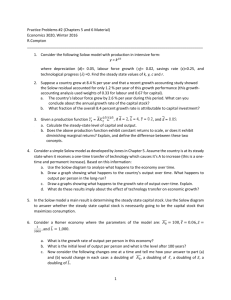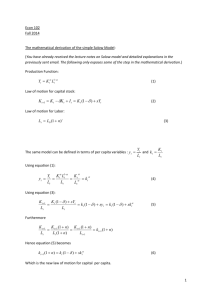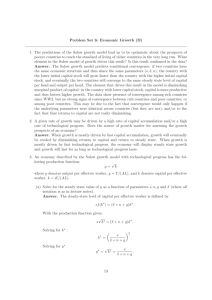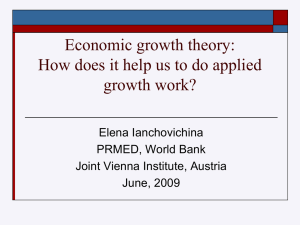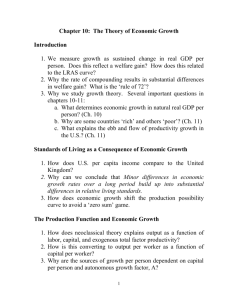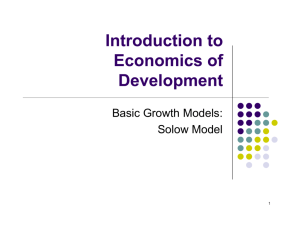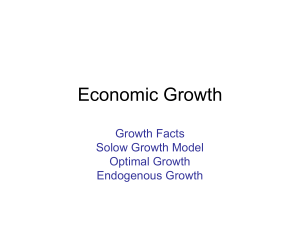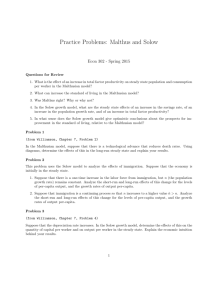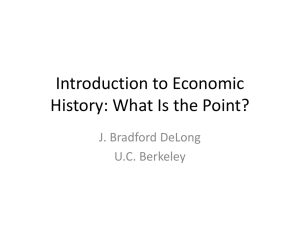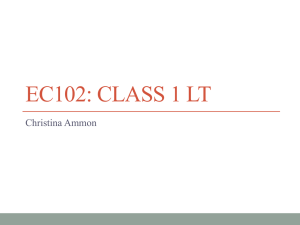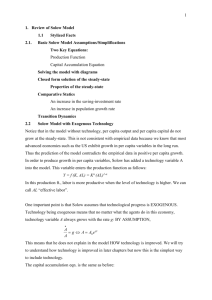The Neoclassical Growth Models
advertisement
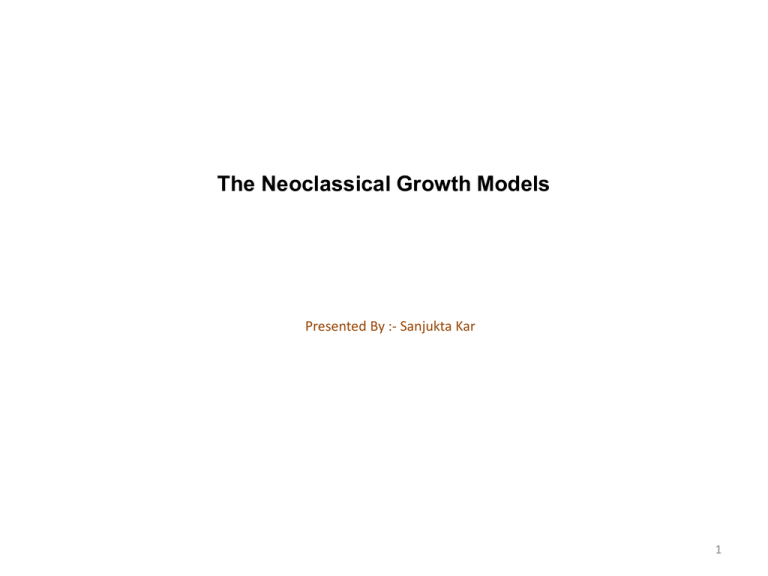
The Neoclassical Growth Models Presented By :- Sanjukta Kar 1 Introduction I will discuss the Solow Swan model which points out the effects of saving, technological advance and population expansion. Next I go over the Ramsey, Cass and Koopmans's closed economy model with intertemporally utility maximizing infinitely lived generations. Lastly, I discuss a version of the overlapping generations model. 2 The Solow Swan Model of Fixed Savings Solow and Swan (1956) incorporated a supply side to the Keynesian aggregate demand framework. Lets look at the modelThe new element which is of interest is technological progress. Technological shocks are classified as Hicks Neutral with production function as— where A is the exogenous productivity parameter, Harrod Neutral with production function as— where E is the labor augmenting technological shift parameter and EL is the supply of efficiency units of labor. 3 The demand side-- The economy is closed and there is no government. Private savings S is a fixed fraction s of current income Y. So we can write1. We have a closed economy. So domestic savings= domestic investment. The capital accumulation equation is given by – 2. Where delta is the rate of depreciation. The level of Harrod Neutral productivity E grows at the rate 3a. 4 The population grows at the rate (3b) Our next step is to normalize all variables by the efficiency labor supply “EL” . The capital to efficiency labor ratio is (4) We divide the capital accumulation equation by efficiency labor unit to get-- (5) (6) where (1+z) =(1+n) (1+g) Re-writing equation 5 as (7) 5 where function. is the intensive form of the production Equation (7) is the main equation of the Solow Model. The first term inside brackets is the gross savings per efficiency worker in period t. The second term inside brackets shows k decreases due to depreciation and the growth in efficiency unit of labor. We divide the term in brackets by 1/(1+z) as any effect on net investment in period t will be felt by efficiency workers in period (1+t). Now the Solow Swan model is represented diagrammatically-- 6 7 Comments - We have a concave production function and a concave savings curve as savings is proportional to output. The distance between the two curves is the consumption per efficiency unit of labor. The 45 degree line gives the savings needed to maintain any level of capital in efficiency unit. Dynamics When the savings are inadequate to maintain the capital stock. So the capital per efficiency unit is falling. We have . The opposite happens when capital stock is low. Overtime the economy converges to the steady state where we have equality. Eventually we get the long run equilibrium at which we have 1) is constant 2) As EL grows at the gross rate K and Y also grow at the same rate. 3) Steady state per capita output Y/L grows at the rate of technological advance 8 Implications Effect of a decline in savings rate When savings fall capital efficiency labor ratio falls. Per capita income falls. The growth of these variables fall temporarily. Eventually the economy adjusts to its new lower levels and achieves its former level of growth. Effect of a rise in the population growth rate Reduces the steady state output per capita as line rotates upward as capital per efficiency unit falls. Economic logic -- Solow model has the assumption of fixed savings rate. So a higher population diminishes the capital resources. 9 The Ramsey- Cass - Koopmans Growth Model with Infinitely Lived Representative Dynasty Let’s think of a world with identical and infinitely lived dynasties. Each dynasty have a size L and they grow at an exogenous rate of (1+n) so that we have We have egalitarian dynasty planners who weigh the consumption of each generation in proportion to its size. At each date t the representative household maximizes (8) where ct is the consumption of the representative member alive at time t. Condition for bounded dynasty utility is As with Solow the labor augmenting technological progress is given by There is no depreciation. The budget constraint is (9) 10 Dividing by Lt we get (10) Here we are dealing with per worker production function. Maximizing equation 8 with respect to equation 10 we get the first order Euler equation- (11) With isoelastic production function (12) we have the following Euler equation (13) Dividing both sides of 10 and 13 by EL we get (14) (15) 11 Steady State values We get the steady state value of capital per efficiency labor when consumption is not changing as given by the vertical line. (16) We get the steady state value of consumption per efficiency unit of labor when capital is not changing as given by the hump shaped curve. (17) 12 Dynamics of the Model To the right of the steady stock of capital the capital is above its steady state value, so the marginal product of capital is below the steady state value of marginal product. So consumption is falling. Consumption rises to the left of the vertical line. If equation 14 is less than zero then consumption is above its steady state value. We have a zone of rising consumption and falling capital. For any initial level of capital per efficiency unit there is an unique consumption thus enabling the economy to move along the saddle and converge to the steady state. 13 Implications Effect of a decline of the patience factor beta 14 People consumes more and savings decline. `From equation 16 we find the steady state value of capital per efficiency unit falls as people become more impatient i.e. they have a lower beta. This situation is analogous to the fall in savings rate in the Solow Model. A lower beta leads to an upward jump in consumption to the new saddle path. But we find the capital stock has fallen as well. So lower capital stock leads to a decline in output per efficiency unit and consumption per efficiency unit and in the new long run position the new consumption is lower than the initial steady state value. 15 Effect of a rise in the population growth rate 16 The unchanged. schedule shifts down but the schedule is At the new steady state we have Unchanged capital stock per efficiency unit. Unchanged output per efficiency unit A decrease in consumption in efficiency units. Difference with Solow - The path of output is doesn't fall as opposed to the Solow Model. with a fixed savings as we have forward looking planners who take care of the utility of the future generation in making today’s consumption choice. When they expect a higher population in the future they cut back on consumption today to provide the same path of capital and output for their progeny. 17 An Overlapping Generations Growth Model Assume individuals maximize utility according to the utility function (18) Total population = labor supply and grows at the rate n. Each period agents earn income from wages and from renting out capital. The budget constraint is (19) v is defined as family vintage. Maximizing utility with respect to budget constraint we get the Euler equation (20) Using and per capita terms. = we get the budget equation in 18 Using and = we get the budget equation in per capita terms. (21) By using we get the closed economy overlapping generations model as (22) 19 Dynamics 20 Like before a rise in population shifts the curve downwards. schedule moves upward. We have a reduction in capital labor ratio like the Solow model. As the present generation does not care about unborn future generations the steady state capital stock will be inefficiently high. 21 Comments Questions? Suggestions? 22
